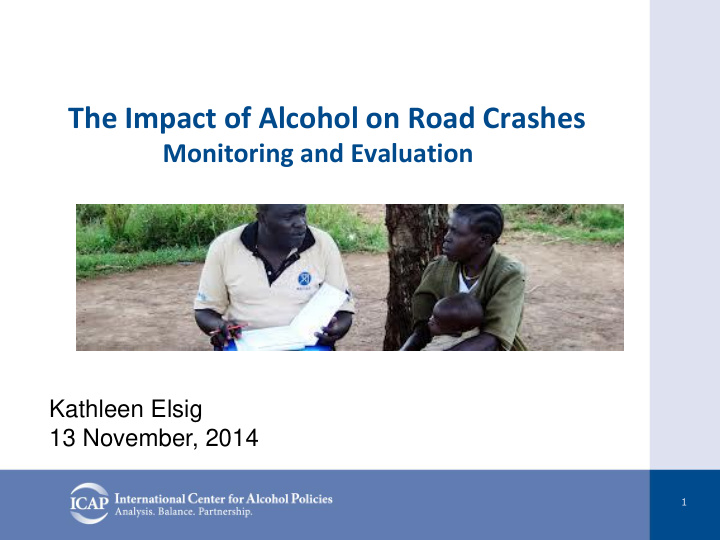



The Impact of Alcohol on Road Crashes Monitoring and Evaluation Kathleen Elsig 13 November, 2014 1
Why Evaluate? • Justify use of resources (human, financial) What is the story you want to tell • Identify areas of success people about your project? • Identify reasons for lack of success • Identify progress within the behavior change process • Build better programs in the future • Communicate actual outcomes and progress 2
M&E and road safety data? M&E activities can provide an excellent «micro» view of the road safety situation 3
When to begin thinking about M&E? • In the planning stage • Link M&E with the objectives of your activity • Be clear on what you want to achieve, the steps you will take to achieve your objectives, who is the target audience 4
What do you want to evaluate? • Was the activity P r ocess Process was carried out evaluation as planned ? • What are the Impact long-term, assessment Impact deeper changes resulting from the activity? • What kind of Outcome change has evaluation occurred as a Outcome result of the activity?
Collect before, during and after the activity Information types and sources 50% of respondents know the legal BAC limit Quantitative information befoe and 75% after 75% of drivers were buckled- Responses from surveys up before, 85% after Observation studies 8% of drivers tested were Enforcement data (pre-program) above the legal BAC level before an 2% after Qualitative information Individuals responded Individual interviews enforcement should be Focus groups strengthened Focus group discussions show young men feel the level of risk for being breath tested is low 6
Process evaluation • Answers the questions • Were all planned activities actually implemented? • Were activities implemented on time? • Were activities implemented within budget? • Indicators you can measure • Activity milestones (e.g. events, police check-points) • Timeline • Budget • Relatively simple to undertake
Impact assessment • Answers the questions • Did the activity achieve the desired impact? • What were the impacts of the activity? • Indicators you can measure • Quantitative and qualitative • e.g. nr of drink drive incidents and fatalities • e.g. nr. of drivers over the limit • More complex to undertake. Requires long-term commitment for evaluation.
Outcome evaluation • Answers the questions • What has changed or is different as a result of the activity? • Indicators you can measure • Quantitative and qualitative • e.g. improved knowledge, attitudes and perception, • e.g. legislative change • Relatively simple. Requires short-term commitment for evaluation.
Evaluation – study types for drink drive activities Process Project plan with timeline, evaluations milestones, budget etc • Impact and Randomized controlled trials • Before – after study outcome • Interrupted time series evaluations • Qualitative + Quantatative research - focus groups, interviews, surveys
A few words about monitoring… • Undertaken throughout implementation • To understand progress and manage risks • Information collected can be qualitative and quantitative • Enforcement – hours of activity, number of drink drivers, level over the legal BAC • Communication – audience response, message understanding, misconceptions, media effectiveness, knowledge of law, etc. • Crash and health data – fatality and injury trend, health data • Word of Mouth – industry response, patron response, community views, media commentary, talk back radio 11
Putting it together Possible Possible Possible Performance Measurement Objectives Indicators tools • Police crash data Reduce the number of Fewer deaths, injuries deaths, injuries drink- from crashes involving • Health sector data drive crashes driver with illegal BAC Reduce the number of • Police breath test data Fewer drivers over the drivers who are legal BAC limit • Health sector data drinking and driving … by gender, age • Pre/post campaign survey Increase action in More community drink- • Increase in number of community to prevent drive prevention drinking and driving community activities activities • Number of court cases for • Pre – post campaign Increase number of drink-drive data from justice drivers prosecuted for Septemb • Fewer drunk drivers • Increase in (RBT) drink-driving er 2008
The M&E Situation assessmet Lessons Planning learned Implementation Evaluation + monitoring 13
A ‘Practical’ Evaluation • Accept that not all things can be controlled • Try to control for obvious influences (i.e. don’t measure drink driving outside licensed premises or major events) • Measure before and after program and before and after major program components (i.e. enforcement periods, publicity phases) • Measure after the end of the activity (e.g. 12 months) to determine longer term impact, performance and to build trend data. 14
Summary… • Plan your evaluation in at the start • Program monitoring is vital for success • Be practical about what is possible • If funds are desperately short spend the money on qualitative research, especially understanding the target group. • Lessons learned can be used to strengthen future activities • Anything can be evaluated – workshops, training, conferences, projects, campaigns etc • We can learn important lessons from success and failure 15
Thank you for your attention www.icap.org 16
Recommend
More recommend